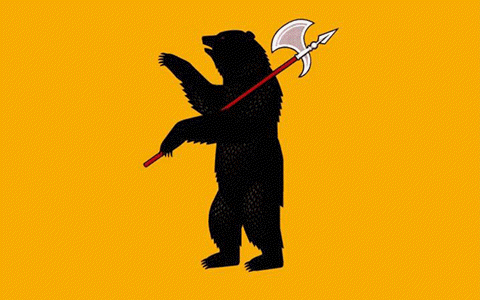
A pal of ours recently quipped that he’s always had a yen to visit Mozambique, albeit because he’s always dreamed of traversing the sandy beaches of the Bazaruto Archipelago. No, our friend is attracted to the nation for a single, simple reason: he digs flags that feature weapons, and Mozambique’s official banner certainly qualifies.
Given his proclivity for flags that nod toward bellicose intentions, where else should our great pal add to his dream itinerary? There are far more choices than we ever dreamed, but none boasts a flag quite as sublimely badass as Yaroslavl Oblast. The angry bear would be reason enough to applaud the patriotic design, but the heavy battle axe really functions as a perfect cherry to the vexillological sundae.
We’re by no means the first folks to take note of the Russian region’s supremely awesome flag. But how did the good folks of this oblast luck into such a great symbol? The backstory only adds to the allure:
Yaroslavl was established in 1010 A.D. by Yaroslav the Wise of Novgorod and Kiev fame. Legend has it that he and his companions came across this area, where a village of some pagan, bear-worshipping people was located. He felt that this spot would be a good one on which to build a citadel and suggested that the locals become Christians and his subjects. They refused. So he made a deal with them: he would fight/wrestle a bear of their choice. If the bear killed him, that would be the end of the story. If he killed the bear, then the pagans would accept the Christian God and join his domain. Well, Yaroslav managed to kill the bear with his battle axe, and his opponents then became his subjects. His built a kremlin overlooking the Volga River, which the Bolsheviks later tore down. But the city’s coat of arms remains a bear carrying an ancient battle axe.
Another version of the tale claims that Yaroslav didn’t best a mere champion bear, but rather a bear demi-god worshipped by the locals. Not sure we buy that, though.


Gramsci // Nov 10, 2009 at 11:06 am
So the starry-eyed conqueror does NOT get killed by the bear? Werner Herzog sadly shakes his head at the film that might have been.
Brendan I. Koerner // Nov 10, 2009 at 11:07 am
I’m sure the Russian scribes would’ve written a more Herzog-friendly tale if movie options existed back in 1010.
The Mother of All Marvin Covers // Nov 10, 2009 at 1:03 pm
[…] pal who lusts after a Mozambique holiday also co-hosts one of the best Internet radio shows you’ve never heard of: Fresh Produce, […]